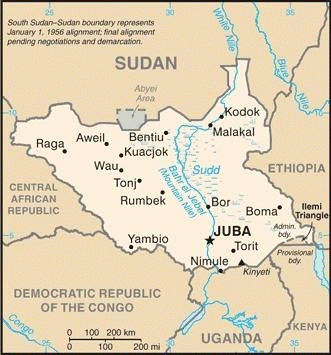|
South Sudan
|

|
Capital: Juba (capital) 525,953 (2017 estimate)
Population: 12,118,379 (2023 est.)
Brief History of South Sudan:
South Sudan gained independence from Sudan on July 9, 2011. As of the writing of the article, it is the world’s newest country. The country is home to a diverse array of people that settled in the territory in the 15th through 19th centuries. Their society is very dependent on seasonal fluctuations in rain and seasonal migration. The region of South Sudan was originally conquered by Egypt and later ruled by Egyptian-British colonial administrators in the late 19th century. Christian missionaries spread of English and Christianity throughout the region. This was different than the northern region of Sudan which spoke Arabic and was primarily Islam. This led to significant cultural differences between the northern and southern parts of Sudan.
Since independence, South Sudan has struggled to form a viable government and has seen a lot of government struggles and local violence.
The Geography of South Sudan
Total Size: 644,329 square km square km
Size Comparison: slightly smaller than Texas
Geographical Coordinates: 8 00 N, 30 00 E
World Region or Continent: Africa
General Terrain: plains in the north and center rise to southern highlands; the White Nile is the major geographic feature of the country; The Sudd, a large swampy area of more than 100,000 sq km, dominates the center of the country
Geographical Low Point: White Nile 381 m
Geographical High Point: Kinyeti 3,187 m
Climate: hot with seasonal rainfall influenced by the annual shift of the Inter-Tropical Convergence Zone; rainfall heaviest in upland areas of the south and diminishes to the north
Major cities: Juba (capital) 525,953 (2017 estimate)
The People of South Sudan
Type of Government: Republic of South Sudan, presidential republic
Languages Spoken: English (official), Arabic (includes Juba and Sudanese variants), ethnic languages include Dinka, Nuer, Bari, Zande, Shilluk
Independence: July 9, 2011 (from Sudan)
National Holiday: July 9, 2011 is Independence Day
Nationality: South Sudanese
Religions: Christian 60.5%, folk religion 32.9%, Muslim 6.2%, other <1%, unaffiliated <1% (2020 est.)
National Symbol: African fish eagle; national colors: red, green, blue, yellow, black, white
National Anthem or Song: South Sudan Oyee! (Hooray!)
Economy of South Sudan
Major Industries: Oil production, mining, agriculture, tourism
Agricultural Products: milk, sorghum, vegetables, cassava, goat milk, fruit, beef, sesame seed, sheep milk, mutton
Natural Resources: hydropower, fertile agricultural land, gold, diamonds, petroleum, hardwoods, limestone, iron ore, copper, chromium ore, zinc, tungsten, mica, silver
Major Exports: crude petroleum, gold, forage crops, lumber, insect resins
Major Imports: cars, delivery trucks, packaged medicines, foodstuffs, clothing and apparel
Currency: South Sudanese Pound (SSP)
National GDP: $20.01 billion (2017 est.)
** Source for population (2012 est.) and GDP (2011 est.) is CIA World Factbook.
Back to Geography Home Page
